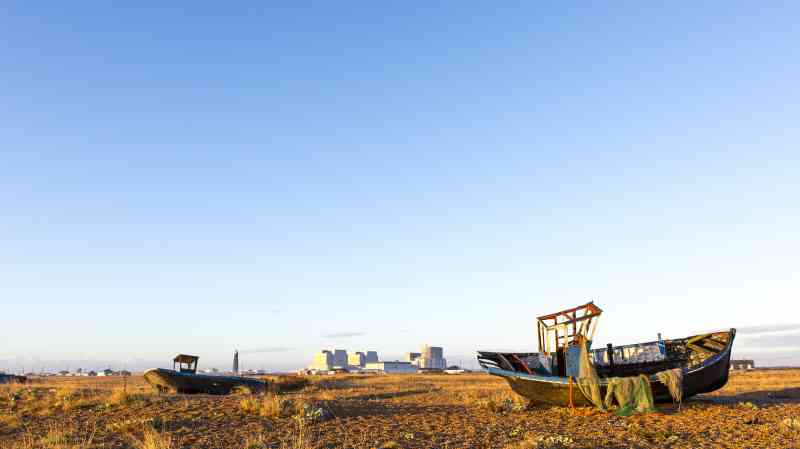In the control room of the Hinkley Point B nuclear power station in Somerset yesterday morning, engineers pressed a button to trigger the shutdown of one of its two reactors. Within seconds, 81 control rods were pushed through channels in graphite bricks into the reactor core, stopping the nuclear reaction. Cooling systems were activated that should reduce the reactor temperature low enough for safety inspections this week.
It’s a process that has been carried out dozens of times since Hinkley Point B started generating in 1976. This time, though, could be one of the last. The graphite bricks that are crucial to its safe operation are getting weaker with age and are developing cracks. The plant’s other reactor has been shut down since February for inspections; neither is expected to restart for months. While Hinkley Point B is not scheduled to close for good until 2023, there are doubts over how much it can keep generating in the meantime.
Britain has eight remaining nuclear power stations, which typically generate about a fifth of the country’s electricity. They have been operated since 2009 by EDF, the French power company that owns 80 per cent. Centrica, the British Gas owner, owns the other 20 per cent.
EDF’s plans for new nuclear plants grab most of the headlines, but with its Hinkley Point C project in progress and not scheduled to start generating until 2025 and with a proposed sister plant in Suffolk aiming for the early 2030s, the fate of the existing stations will be equally key to determining the role of low-carbon nuclear power in Britain’s future energy mix.
All bar one of the existing stations, including Hinkley Point B, comprise twin advanced gas-cooled reactors, or AGRs, built between the 1960s and the 1980s. All the AGRs are scheduled to close permanently between 2023 and 2030, but all also have graphite cores that bring their lifespans into doubt.
“They will all at some stage exhibit some form of cracking towards the end of life,” Richard Bradfield, chief technical officer for generation at EDF Energy, said. “There are two irreplaceable components on an advanced gas-cooled reactor: the graphite and the boilers. Even from day one back in the 1960s, it was always going to be, ‘Which is going to win?’”
At Hunterston B in North Ayrshire, Hinkley Point B’s sister station, the graphite is damaged more severely. At an inspection in March 2018, EDF found more cracks than it expected in one of the reactors. Its restart date, originally scheduled for later that year, has been delayed repeatedly pending approval from the Office for Nuclear Regulation. The other reactor, which was found in October 2018 to be slightly less cracked, has been allowed to run for only four months since.
To restart them, EDF must prove that control rods can still be inserted through the graphite to safely shut down the reactors, even in the event of a huge earthquake. “We describe it as a once-in-10,000-year event; an earthquake magnitude such that has never been seen in UK and would have to be pretty much on top of the power station,” Mr Bradfield, 53, said.
EDF has spent more than £200 million on tests, inspections and creating quarter-scale models of the reactor cores that are shaken to mimic a quake to try to prove that the graphite is safe. Recently it submitted a new safety case to the regulator for the most severely cracked Hunterston reactor, which it hopes will be approved in July to allow the next six months of operation. That may pave the way for approval for the second reactor and, later in the year, for Hinkley Point B, which has “pretty much the same safety case”.
A third plant, Dungeness B in Kent, has been offline for different safety issues since the late summer of 2018, when repairs needed to steam pipes were identified. EDF then discovered that further work that was needed to tackle corrosion on the boiler and it has repeatedly delayed the restart.
Mr Bradfield said that the boiler design at Dungeness was “very different” to the other AGRs and probably would be the life-limiting factor for the plant. However, he said that the issues were “manageable” and that the company aimed to present a safety case shortly to seek to restart in September.
Yet some onlookers question how many of the reactors will ever be switched back on. Martin Young, an analyst at Investec, said that although EDF had secured life extensions to the plants since acquiring them in 2009, it may now have “hit the buffers on some of them”. EDF insists that it intends to operate Hunterston B and Hinkley Point B until 2023, but Mr Young noted that the company had chosen not to enter Hunterston B into the government’s “capacity market” auction in January, which would have offered it payments to guarantee that it would be available to generate in 2022-23. Hinkley Point B was entered into the auction but EDF did not secure a contract.
“There has to be a risk that they shut down for good,” Mr Young said. “You’re getting to the point where the old stuff is creaking at the seams. There has to be a situation where you get to the point that a power station, if it is going to close in 2023, might not be worth reopening.”
For now, Mr Bradfield said, EDF is confident of its safety case and that the investment in proving that the cracked graphite is safe is worth it. “The £200 million is to support all the advanced gas-cooled reactors,” he said. “It is a lot of money, but in terms of securing optimal life for the UK in terms of low-carbon generation it’s not a huge amount. It’s about one reactor’s income for one year, so if you’re talking about fourteen AGRs continuing to generate, it’s well worth investing in.”
